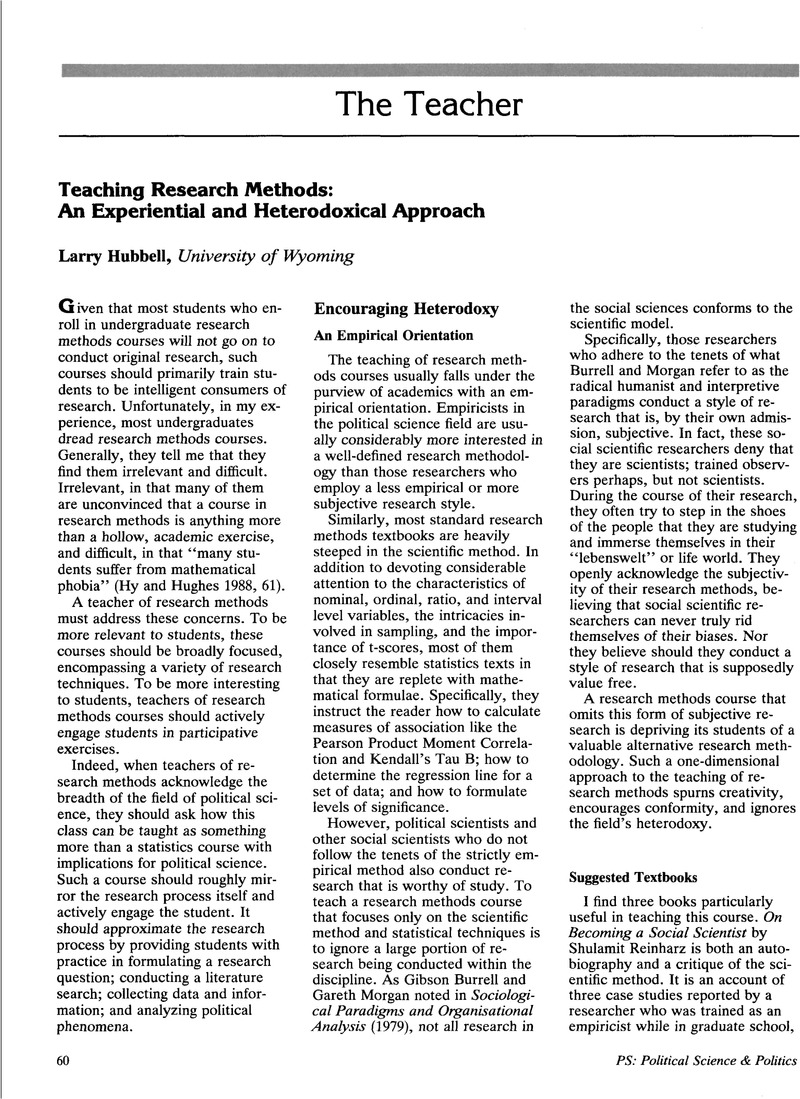Crossref Citations
This article has been cited by the following publications. This list is generated based on data provided by Crossref.
Gum, Amber
Mueller, Kalah
Flink, Daryl
Siraj, Shaila
Batsche, Catherine
Boothroyd, Roger
and
Stiles, Paul
2007.
Evaluation of a Summer Research Institute in Behavioral Health for Undergraduate Students.
The Journal of Behavioral Health Services & Research,
Vol. 34,
Issue. 2,
p.
206.
Dickovick, J. Tyler
2009.
Methods in the Madness: Integrative Approaches to Methodology in Introductory Comparative Politics.
Journal of Political Science Education,
Vol. 5,
Issue. 2,
p.
138.
Schofield, Cathy
and
Burton, Francesca
2011.
The development of a research methods toolkit to support sport science undergraduates and lecturers.
Journal of Applied Research in Higher Education,
Vol. 3,
Issue. 1,
p.
28.
Lau Bertrand, Julia M.
and
Schaefer, Emily
2013.
Training Future Political Scientists: Reflections from an Undergraduate Research Methods Course.
SSRN Electronic Journal,
Emery, Jenna Kelkres
Howard, Alison D.
and
Evans, Jocelyn
2013.
The Pedagogical Value of Polling: A Coordinated 2012 Exit Poll Project across Diverse Classrooms.
SSRN Electronic Journal,
Kollars, Nina
and
Rosen, Amanda M.
2017.
Who’s Afraid of the Big Bad Methods? Methodological Games and Role Play.
Journal of Political Science Education,
Vol. 13,
Issue. 3,
p.
333.
Ramdani, Yani
Kurniati Syam, Nia
Karyana, Yayat
and
Herawati, Diar
2022.
Problem-based learning in research method courses: development, application and evaluation.
F1000Research,
Vol. 11,
Issue. ,
p.
378.
Thornburg, Matthew P.
and
Botsch, Robert E.
2023.
The Palgrave Handbook of Teaching and Research in Political Science.
p.
259.
Ramdani, Yani
Kurniati Syam, Nia
Karyana, Yayat
and
Herawati, Diar
2023.
Problem-based learning in research method courses: development, application and evaluation.
F1000Research,
Vol. 11,
Issue. ,
p.
378.
Lam, Man Ho Adrian
and
Hung, Ho Ting (Bosco)
2024.
Comparative Analysis of the Undergraduate Political Science Research Methodology Course Syllabi among Hong Kong Universities.
Journal of Political Science Education,
Vol. 20,
Issue. 4,
p.
572.
Furlong, Darcy E.
Romero, Anna
Helström, Kirstin
Lester, Jessica Nina
and
Karcher, Sebastian
2024.
Teaching with shared data for learning qualitative data analysis: a multi-sited case study of instructor and student experiences.
International Journal of Research & Method in Education,
p.
1.
Marleku, Alfred
Peshkopia, Ridvan
and
Voss, D. Stephen
2024.
Research-oriented Studies in Political Science: How Research Collaboration Shapes Southeast European Student Learning Preferences.
Journal of Political Science Education,
Vol. 20,
Issue. 1,
p.
31.



